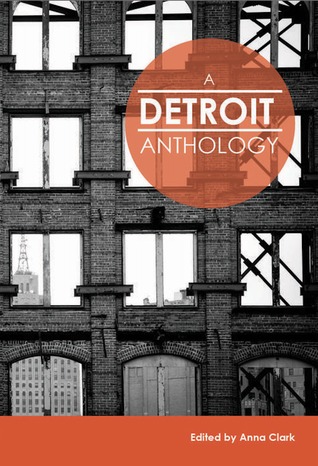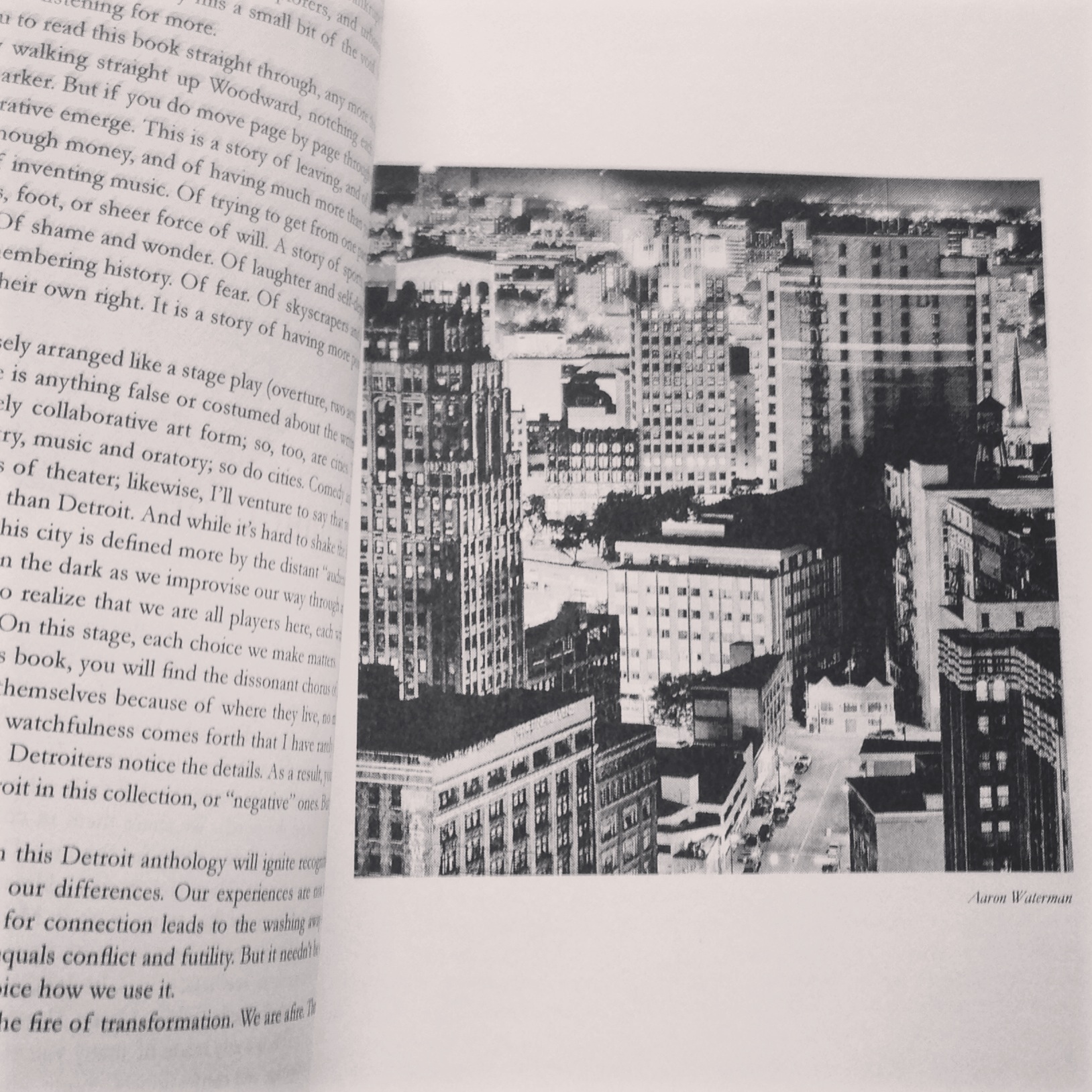When I was an undergrad at Central Michigan University, I started as a music performance major and shortly thereafter switched to creative writing. However, my favorite class happened in the history department with Professor David Goldberg: Black Detroit. If you click his name, you’ll see a list of what he now teaches at Wayne State University (in Detroit, Michigan) — and it’s amazing!
Since then I’ve been trying to keep up on books about Detroit. Recently, Detroit Hustle failed to impress me. I had higher hopes for A Detroit Anthology, edited by Anna Clark, because she includes a variety of Detroiters’ experiences. People young, old, black, white, Muslim, Christian, Jewish, immigrant, migrant, downtown, in the corners of the Detroit map, male and female. They agree and disagree on the same subjects, giving unique perspectives each. Yes, some of the authors are male, but I still review anthologies edited by women with male authors contained within the work because an editor has to shape the product she wants to see on the shelves, and it’s no easy task to curate a book meant to capture a place in photography, essays, narratives, and poems.

The organization of poems, essays, and narratives was the best part about the anthology. Clark puts together similar works. For example, you get a prose poem about street cars, then an essay about Detroit being a city for drivers, followed by a narrative about a woman whose car is vandalized, and then a narrative about a man who leaves Detroit and lives car-less for fifteen years before he concedes he must have one when he returns to “the D” (as locals call it). The topics build naturally from one another.
Though the organization was excellent, the photographs didn’t suggest a progression the way written works did and lacked helpful labels, in my opinion. In fact, the low quality of printing means image of people in action or buildings far away appear grainy.

Is it the job of the editor of the anthology to edit the works or secondary editor/proofreader to make sure everything is formatted and spelled correctly? A few cases of too/to and commas formatted next to the wrong word (e.g. “town ,competed”) distracted me. There was a paragraph indented twice.
Someone needed to edit each piece in the collection, which I realize would be a huge job. The book has sixty works, not including photos. But here is a sentence that I read and re-read to make sure I got it right:
Remember your first day of school? How your outfit had to be just right? Or how the crusts had to be cut off your sandwich and carefully placed in the lunchbox with your favorite cartoon character on it?
I feel like this child is going to be a Detroit-style Oliver Twist with only bread crusts for lunch. Then there is the poet who confused the saying the canary in the coal mine, instead using the bird as a metaphor for calling someone to a better place:
I almost forgot
to mention: the canary in Detroit's proverbial coal
mine who sang for my parents when they fled
the inferno of the South, its song
sweaty sweet with promise. I'm singing
myself, right now.
I mean, the canary warns you that you’re about to die. There is no promise there, nothing sweet — the bird is dead. And if the canary is in Detroit while the poet’s parents are in the south, why would they race toward the dead bird? It can’t sing; it dies and that how coal miners know to GTFO.
The topics covered made me feel like I was in a crash-course version of that Black Detroit class. The writers cover white flight, music, sporting arenas, housing, unemployment, crime, drugs, religion, the 1967 riot, slow EMT and police response time, Greek Town, family-owned businesses, farmers markets and urban gardening, the auto industry, transportation, poverty, HIV/AIDS, schools, and downtown growth. Mostly, the essays are too short to support a thesis, the narratives too short to fully describe an experience and its impact, the poems too disconnected from the city.
Overall, I appreciated that A Detroit Anthology made me reminisce about things I already know, yet couldn’t recommend it to someone who wants to learn about the city. The works are just too short.

Grammar and punctuation: The difference between eating a sandwich without crusts, or crusts without a sandwich 😂
LikeLike
You see it, right?? I’m not confusing myself?
LikeLiked by 1 person
It’s definitely not just you! 😋
LikeLiked by 1 person
I do hate poor formatting or editing – it’s just so distracting!
LikeLike
I get that small presses have limited staff (and I’m not sure even sure the press IS a small press), but couldn’t each writer have two good friends check over their piece and make sure everything is how it should be?
LikeLike
It sounds like this anthology was almost something amazing. Given some stronger editing, photographic printing and connection to the written pieces, this could have been great. I love the idea of each piece connecting to the one before it as the content transforms and moves forward. The subtlety appeals greatly to me. I get bored with anthologies that thrust connections between pieces in my face or only have one overarching connection.
There are over 60 works and yet they are too short? How long is the average written piece?
LikeLike
Each piece is about two pages long, meaning someone tries to describe a deep narrative or make a point in that amount of time. Only one narrative felt the right length, one about two girls waiting on the bus on a hot summer day when one girl hears Run DMC for the first time. It was a perfect slice-of-life narrative, which is about all you can capture in two pages.
LikeLike
60 works is so many! I’m also wondering how long the average piece is, as well as the length of the collection. I can understand the editor’s desire to represent a variety of writers, but after a certain point none of the voices get the chance to “speak” or put forth a meaningful argument.
LikeLike
A couple of folks have multiple pieces, but not many. Each piece is about 2 pages long, so no, no one really gets to have a loud voice. I took notes on each piece to remind myself what was in this collection, which is 240 pages, and that’s how I noticed the strong connections between each.
LikeLiked by 1 person
Hm, the job of the editor is to find the pieces and/or commission them, put the order together and read over the texts for content (I’d say the canary thing would be their job), and to decide which style guide is being used if the press doesn’t have a preference. The secondary or language editor or the proofreader would check the fine detail, editor for words and grammar and confusions (the crusts!) and comma placement, the proofreader for indents, or just one person doing the lot. Sounds like that second person wasn’t there. Which is a shame as it undermined a good (for certain purposes) anthology.
LikeLike
I’ve been thinking more about who would be the audience for this anthology. In the introduction, Anna Clark says these are stories by Detroiters for Detroiters. Since that is the audience, I guess the short narratives, essays, and poems don’t need the context I think they should have. I still believe two pages is not enough to tell a story about a large topic and then convey the point of telling that story.
But yes, secondary editor, where were you!?
LikeLike
I thought there was a cartoon character sitting on the crusts (I love crusts, I eat other people’s if I get the chance, and anyway I don’t think my mum would have cut them off even if I had wanted her to). I don’t think you ever mention travelling – do you go back to Detroit? Is it still half empty, derelict? I remember your review of a yuppy woman who moved there to take advantage of low house prices.
LikeLike
Ha! Yes, that book was Detroit Hustle, and you describe her perfectly. She tried to fit into Detroit then admits at the end of the book that she moved into an entirely white neighborhood despite Detroit being 140 square miles and 85% African American. I haven’t been back in Detroit in many years. I’d love to check out the writing scene there. Several years ago, I reviewed Wrestling the Muse by Melba Joyce Boyd, a biography about the man who ignited and kept alive the black poetry movement in the U.S. Many famous writers got their start with his press.
LikeLike
Hm yes I’d have to agree with your other commenter that 60 works is just too many-stuff starts to slide downhill after 30 I find. There’s no way that any attention to detail can be paid when there’s so much going on, and clearly this book suffered because of it! That must be frustrating for everyone involved…
LikeLike
The editor, Anna Clark, has a book she wrote about the Flint water crisis, and I plan to read that one. Her organization suggests she is a good writer, so I’m going to give that book a go.
LikeLiked by 1 person
I think it’s a great idea to put together an anthology as a sort of representation of a place. Too bad it didn’t quite work. I didn’t see the bread crust thing until I read it again!
LikeLike
Those dangling modifiers haunt my dreams, Naomi. “I see dangling modifiers. They’re everywhere, and they don’t even know they’re dangling.”
LikeLiked by 1 person